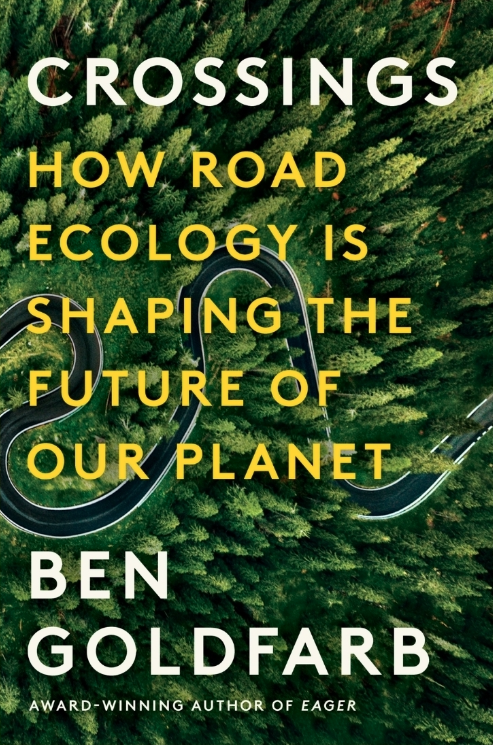
Armchair Birding: Crossings: How Road Ecology is Shaping the Future of Our Planet, by Ben Goldfarb
~ Anne Kilgannon
Recent readers of the New York Times book review of Crossings may have come away with the notion that Goldfarb’s new book is more about the human side of road infrastructure than the challenge roads present to every other being with whom we share living space. True, he does include important discussions about how roads have been the means of dividing human communities and exacerbating inequalities and spreading noise and pollution, as mentioned in the review, but that comes after a granular examination of how the rest of creation copes—or doesn’t—with our miles and miles of concrete spread over hills, dales and rivers.
He generously describes the indefatigable work of many who have for years and presently continue to examine our roads for the dangers and obstructions they present to moose, elk, deer, bears, snakes, salamanders, frogs and toads, birds of all sizes, mice and hedgehogs, chipmunks, coyotes, cougars, foxes, badgers, armadillos, possums… insects! He has a whole section on monarch butterflies! And don’t forget—he doesn’t—our iconic salmon and other fish and water residents. This book is about their lives and deaths, and how we humans can do better by learning about and addressing their needs to survive and thrive.
The cameo-presented humans themselves are tightly focused on the animals on their watch, first counting them to understand the toll roads exact: literally, how many bodies are roadside to tell the tale of where and how roads pose a danger or an impediment to just getting around or through an area. The death numbers are astonishing, sickening, really, and only represent a portion of the damage done. (Goldfarb explains that many animals will struggle away from the road to die hidden in the bushes where we cannot see them. He also describes the quick work of scavengers—from vultures to insects—who clean up the carnage before we can tabulate it. Their role is also an important part of the story. And not all of them survive their clean-up work; many get hit by cars as they crouch on the side of roads.) He teaches us to see our roads from their points of view, their lives and needs.
Still, field researchers have amassed a pretty clear picture of road impacts, enough to discern patterns and prescribe remedies. The more we can understand animal migrations, feeding habits, nighttime behaviors and the like, the better we can design or mitigate for safer passages, or even relocate roads to areas away from turtle and frog habitats, elk paths to feeding and birthing locations, and young salmon struggling to find the sea and later returning to natal waters for spawning. With knowledge we can design and build bridges, accessible and right-sized culverts and tunnels, guiding fences, warning lights and sensors, and other mechanisms to keep animals and cars separate and safe.
Ironically, many of the improvements in these innovations and practices came about not for the sake of the animals but because of the human toll in deaths and damages to vehicles and structures caused by collisions, especially with the larger animals. But skidding over frogs and insects has its dangers, too! Co-existence, it turns out, can be justified—let’s be pragmatic as needed—by the costs of insurance pay-outs. But more and more, people pressure—you and me—can insist we include animal well-being as a priority when planning transportation projects in the first place and when adapting older structures to the reality of the needs of other creatures. We need to press for better culverts under our roads, for salmon and other creatures using watery passageways for migration, creating greater genetic mixing of populations, and for seasonal foraging. We need to find ways to finance bridges over highways for safer routes for everything from cougars needing mates and better hunting grounds to squirrels that need to extend their ranges.
We need more studies, more imaginative thinking, more empathy for all beings. In short, we need to find more ways to share the earth with all earth citizens, tax paying and not. And we can do it! This book is full of really amazing solutions and practices. As grisly as this topic is—Goldfarb spares neither himself nor his readers in confronting the reality of roadkill—he brims with hope and creative ideas of how we can make a difference. As Mary Oliver in her poem, “Wild Geese” advises, “You only have to let the soft animal of your body love what it loves.” To see the world as a deer or a crow or a monarch butterfly does and then cross the road—safely—as they might need to do. Goldfarb has written a much needed primer to get us there.







